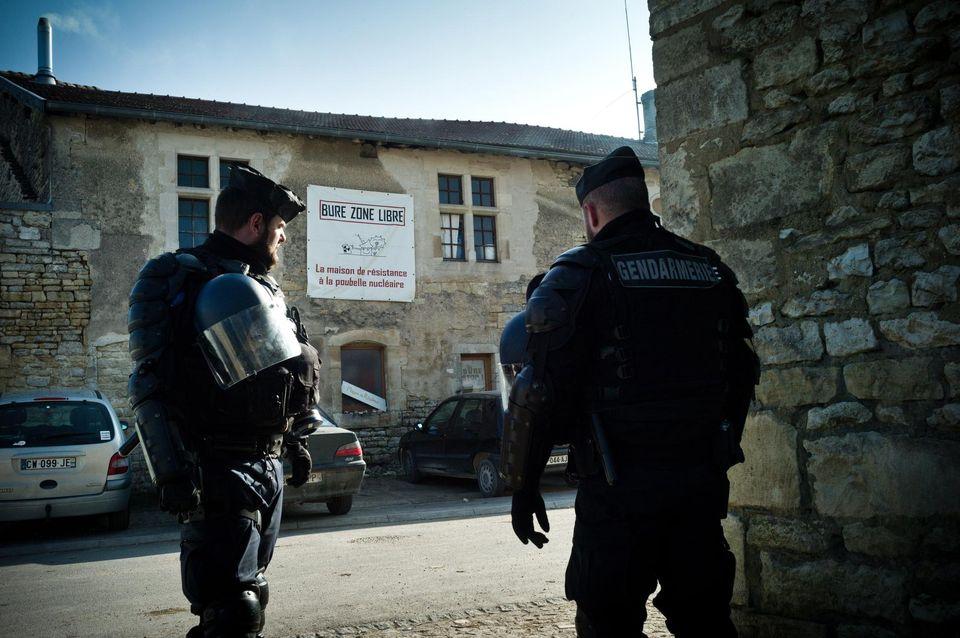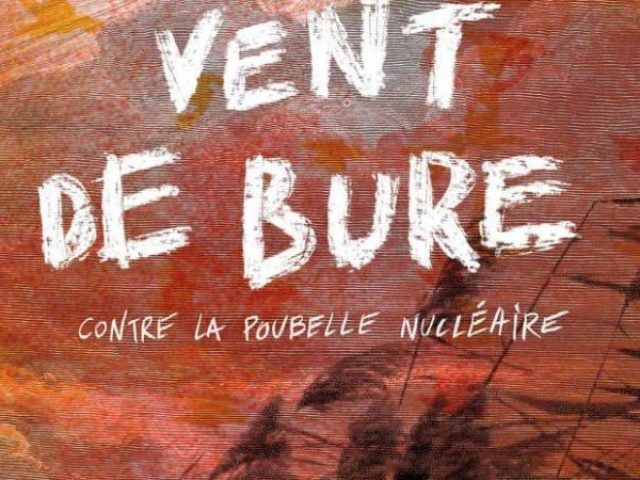Bure: the nuclear zeal of justice

A long read of events in Bure in the Meuse, East of France and how anti terrorist and organised crime laws of June 2016 have been used against activists.
Human translation of article in the French press (the newspaper Libération) after the court case yesterday in Paris in the highest court in France “le cour de cassation”. This was concerning the fact that during the investigation five people can not enter in contact with one another at all and they have restrictions on where they can go.
original article in French here
https://www.liberation.fr/france/2018/11/14/bure-le-zele-nucleaire-de-la-justice_1692100
Bure: the nuclear zeal of justice
They are only a few dozen, yet justice employs huge means. “Libération” was able to consult the case file against the anti-nuclear opponents who oppose nuclear waste dump CIGEO. a titanic procedure using the most advanced resources … of the fight against terrorism.
Has he ever participated in an investigation of this magnitude? After a brief silence, the Bar-le-Duc (Meuse) prosecutor, Olivier Glady, must admit it: “No.” Since the summer of 2017, an open investigation especially for “criminal conspiracy” targets the opponents of the Industrial geological storage center (Cigeo), a vast project for the storage of the most dangerous nuclear waste, in and around Bure. After months of increasing tension between law enforcement and opponents of the project, an event will precipitate the opening of this colossal investigation that resulted in the arrest of seven activists. (who have been charged with criminal conspiracy)
On the morning of 21, June 2017, a handful of people, faces masked, entered the hall of a hotel-restaurant, whose activity depends on the laboratory of the nuclear waste dump project. Upstairs, ten occupants are awakened by the noise. The reception is ransacked, a bottle containing hydrocarbons is thrown to the ground and ignites. As the individuals leave the scene, an employee quickly extinguishes the fire. The public prosecutor will add to his investigation of these acts of
criminal damage committed in February of the same year, in “the ecothèque”, a building belonging to the National Agency for radioactive waste management (Andra). As well as the violence that occurred during an unauthorised demonstration in Bure on 15 August 2017 during which several people were injured.
While these facts, mainly of criminal damage, concern only a few militants, it is the movement as a whole that has been targeted. The clearly stated objective is to highlight the “radicalisation” of some of the opponents with “criminal designs” and perpetrators, according to the “gendarmes” (French police), of “grave breaches having for the moment resulted only in material damage “. In this case, which has already exceeded 10,000 pages and that “Liberation” has consulted, the most intrusive investigations investigators frantically linked.
A “Bure cell” at the gendarmerie (police centre) has been set up in coordination with the Bar-le-Duc prosecutor’s office. A dozen officers work on the movement. Most of them full time. Physical surveillance, geolocation, vehicle marking, tapping, capturing sounds from a house, genetic expertise, searches, exploitation of computer equipment …
These “special investigation techniques” were extended or legalised by the law of 3 June 2016 on organised crime and terrorism. At the time of the debates in Parliament, defenders of public liberties warned against the risk of seeing the methods of anti-terrorism and repression of organised crime applied to political militancy.
By targeting the “criminal conspiracy”, the prosecutor’s office allows investigators to use many means regulated by the 2016 law. “Neither I nor the judge used methods that would not be included in the Code of Criminal Procedure, stresses the public prosecutor of Bar-le-Duc. I comply to what the law allows, not more … but not less. ”
A version disputed by Angélique Huguin, resolute opponent to Cigéo:
” Bure, it is a repressive laboratory. We are dealing with the nuclear industry, so we are dealing with the state. “” Justice uses this judicial information to break and muzzle the protest movement in Bure “, say a pool of defence lawyers for activists. Olivier Glady (the prosecutor) answers by finding a little “paradoxical” the questions on the debauchery of energy: “For once an investigation is carried out until the end, with a deployment of means which is not exposed to the
reproaches of the stinginess that we hear too often in the judicial world … “But he is looking for a way out:” I don’t know what the end of the film will be like and if in the end there will be enough elements “.
Review of details of the methods used
1 Listening, geolocation, markup
Between the opening of the criminal investigation at the end of July 2017 and the undeclared demonstration of the 15th of August, the communications of at least seven telephones are “intercepted”. The “collective” lines, that is to say used by several people, are targeted first. In the list of wiretaps, unsurprisingly, the mobile phones and fixed “Maison de résistance” (house of resistance), which the case designates as “the epicenter of the protests of the project”.
Several activists live permanently in this stone building, bought in 2004 by two associations, and is therefore the subject of all speculation. Determined to know the slightest cogs, the judge, Kevin Le Fur, orders a “sound out of the place”. However, the gendarmes fail to install the microphones in the house, that is continuously occupied. On the other hand, they use the state health insurance organisation and the tax services to investigate the profiles of its residents. Through their massive use of eavesdropping, the gendarmes try to reconstitute the organisation chart of the opponents of the nuclear waste dump project. One line attracts the attention of the investigative cell: the “legal team”, a squad of opponents who have knowledge of legal sides of matters.
On the day of the demonstration of 15 August , during which an activist was seriously injured by a grenade, each call issued or received by the number of the “legal team” is recorded, and this over a period of seven hours: “Call of 18:03 X declares that the demo is retreating at last.
Call of 18 hours 05 and 53 secs: X declares that they go back again and that there are seriously wounded people. »And it goes on for pages and pages. The big ears of the gendarmes will also be interested in more than a dozen activists, whose personal phones are tapped from September 2017. For some, interceptions cease after a few weeks. Others, on the other hand, will be listened to for almost a year. Who’s talking to who ? Who uses a pseudonym? And which one? Investigators struggle to flush out the “criminals” they track down.
Thus, 2,000 interceptedrecorded communications result in only four meagre transcripts … Not to mention the number of a person who has nothing to do with Bure, listened to for a month for nothing.But the exploitation of personal phones is not confined to listening. About ten people were geolocated for several weeks “with a refreshment frequency of ten minutes”. Result of these glaring investigations? Nothing”no interesting item to investigate or likely to help the manifestation of the truth”. Another attempt is to put GPS tags under the vehicles of two people, which is obviously of great interest to the investigators. But again, the discoveries prove pointless.
2 The “Imsi-catchers”
The demonstrations organised by the opponents of the Cigeo project offer the gendarmes new moments conducive to surveillance. The mobilization of 15 August , 2017 will also be one of the nodes of the inquiry. Numerous reports retrace precisely the path of activists and events. A helicopter follows and films the opponents from the sky. Abundant screenshots document the violence committed against gendarmes. In addition to the numbers mobilised for the management of law enforcement, “investigation teams” are “dispatched locally” preventively. They then observe that the protesters “degrade objects in the street ” and “take down traffic signs” .But the many images captured by the police are obviously not enough. A requisition is sent to the chief editor of France Télévisions.
The gendarmes wish to recover “the video copies and photos of the report and the rushes” stating that “the professional secret can not be opposed, except legitimate motive”. The gendarmes also take advantage of the various gatherings to garnish their files of militants with possible new phone lines. Thus, requisitions are sent to the phone operators following the demonstration of 15 August, 2017, to retrieve the list of mobile phones that connected to the antennas of the area. The operation is carried out to “determine networks of knowledge and proceed to the identification of activists present on the scene.”
In February 2018, the investigating judge Kevin Le Fur authorises the gendarmes to use an apparatus even more intrusive: l ‘Imsi-catcher. This “spy bag” acts as a relay antenna and intercepts the communication data of all mobile phones around. It has long been used illegally by the intelligence services before its use in the context of legal proceedings is framed by the law of 3 June 2016 on organised crime and terrorism.
The use of “this technique is made necessary by the fact that it was found that some opponents had changed phone numbers [following searches, ed],” justify the gendarmes on minutes. Clearly, the Imsi-catcher allows to target much more precisely the militants and geolocate them in real time. On 13 February , 2018, the gendarmes make a first capture with the Imsi-catcher near the Bar-le-Duc court where a rally is organised in support of three activists.
Two are there for the deterioration of a wall that encircled the Lejuc wood (where part of the nuclear waste dump must be built) the other for defamation. “Several recordings were made by the IMSI catchers” says the minutes from the report “in the car park of the departmental council” and “in several places around the court.” The next day, the investigators invest Bure early in the morning to “intercept the technical data of opponents of the Cigeo project located at the House of resistance […] and those located on the edge of Lejuc wood”. The operation is repeated less than a month later, on the occasion of the last big weekend of mobilization, 2 and 3, March 2018.
3 The searches and expertises
The instruction is issued unequivocally by the judge Le Fur: the investigators may “conduct all hearings, requisitions, searches, seizures and in a general manner all acts useful to the manifestation of the truth, and this, throughout the national territory.” Dozens of searches followed, triggered in three series of police raids. At the House of resistance, but also huts in the forest or personal homes …: countless places have been raided. From these raidshundreds of mobile phones, computers, hard drives and USB sticks were seized “Digital media” that will be dissected. According to the count of lawyers’ pool of activists, at least 45 technical examinations as well as computers – and even DNA – have already been made.
One month after the rampage and fire attempt of the Bindeuil hotel-restaurant, a report of genetic expertise is made on the bottle containing hydrocarbons, as well as on four pebbles. She concludes that the data collected do not identify DNA or genetic profile. Even finding failure during the analysis of traces found on bottles and a lighter near the ecothèque, in February 2017. Acts in vain, but invoiced tens of thousands of euros, according to the many quotes, consulted by Libération, attached to the investigation documents.
4 The interrogations
In June 2018, Kevin Le Fur believes that the investigation he has been conducting since several months is sufficiently mature to consider the first arrests. So several activists are placed in custody, including the lawyer Etienne Ambroselli. Often, the weakness of the charges available to the gendarmes, despite their investigations, is reflected in their questions. So, more than the targeted offenses, it is the political movement, and its structure, which are used in questioning. Intrigued by the collaborative way of life, the gendarmes wonder how militants “do for hygiene”. Then, all the activities, even the most innocuous ones, are scrutinized: “Who is in charge of the logistics concerning the material, the wood?”, “How do you feed yourselves ?”, “What?” is the owl express? “questions an interviewer. dubious Answer, “A weekly newspaper that has not been published for a month.”
The associations “Sortir du nucléaire” and “Bure Zone Libre owners of the House of resistance, are also at the heart of hearings. Who are the leaders? What can they say about these structures? How are they financed? Are there tensions between them? Corinne François, a historic activist, who belongs to “Sortir du nucléaire”, is also placed in police custody. Its positioning in relation to the most radical activists is questioned: “Do not you feel a disturbing drift of your struggle?”, “Do you think that everyone is reliable in your struggle?”
Her presences at the “maison de réistance”and the content of the meetings held there, are also questioned.Concerning the lawyer Etienne Ambroselli, who defended several activists pursued in other cases, he must primarily respond of his presence at the event of 15 August 2017, dressed in “a kind of mauve fabric”: “Can you tell us what is the meaning of this fabric, or for what purpose is it worn?” At the end custody, the experts are once again solicited to allow the listing of the genetic profile of the “protagonists”.
And when the collection of DNA from the mouth is refused, it is from “biological material” found on the clothes of the interviewees that biologists are invited to work, in this case a “gray boxer shorts” and a “underwear” -with panty liner “. Sixteen months of trawling through data, multiple activists tracked, tens of thousands of euros spent on a hypothetical conclusion at this stage.
10/11/2018
Et sinon, 139 jours avant
on écrivait ça.

Raids and arrests in Bure
https://de.indymedia.org/node/22037 https://de.indymedia.org/node/22035 http://de.vmc.camp/ On Wednesday, June 20, 2018, the fight against the CIGEO project was hit by a wave of house searches. At ... Lire la suite
24/06/2018
Et sinon, 282 jours après
on écrivait ça.

Bure’s wind is coming : from 28 to 29 of septem...
At the end of April we decided to postpone Vent de Bure, taking into account comments of local groups. THANK YOU for telling us what you needed and expect for this event. Postponing is not a decisi... Lire la suite
19/08/2019